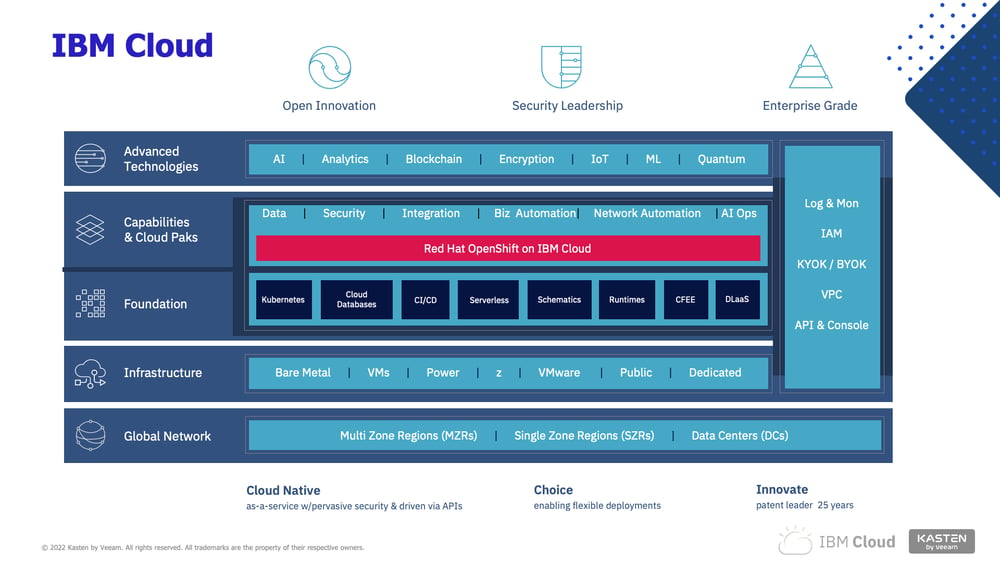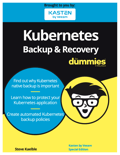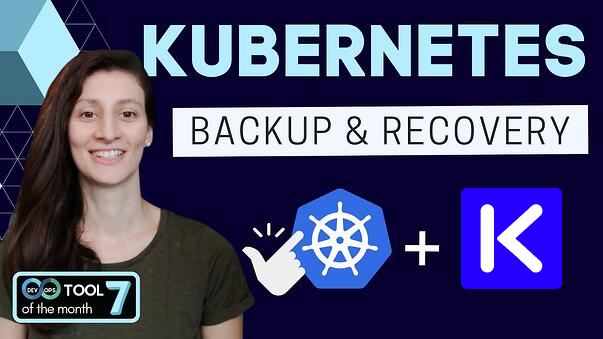How to Eliminate Day 2 Challenges of Deploying Kubernetes with OpenShift + IBM Cloud with Kasten K10
Kubernetes is the fastest-growing infrastructure platform, with over 70% of all organizations using Kubernetes in production. The combination of scalability, portability and a thriving ecosystem has driven the widespread adoption of Kubernetes as a leading container orchestration platform, enabling organizations to take advantage of the speed and efficiency of cloud native development.
At the same time, teams are increasingly adopting shift left processes and CI/CD automation, to improve product quality, reduce costs and accelerate development cycles. In this rapidly evolving environment, it’s critical not to overlook day 2 operations, such as backup, recovery, and data mobility as you transition to cloud native development environments.
In a recent webinar, “Jumpstarting Your Cloud Native Journey,” Chris Rosen, Director of Product Management for IBM Cloud and Kasten by Veeam’s Principal Solutions Architect, Matt Bator, explored pain points and solutions for setting up a Kubernetes environment, and how Kasten K10 by Veeam can be used with Red Hat OpenShift on IBM Cloud to provide reliable backup, recovery and mobility for Kubernetes data and apps.
Where Do You Start?
Designing a Kubernetes infrastructure that supports a hybrid cloud delivery model is no easy task. Numerous considerations come into play. The first big decision, according to Rosen, is whether to do it yourself or leverage a public cloud. If you choose the DIY route, it can be very complex, with requirements for storage, network, compute, security, monitoring, backup and recovery and more.
“There are a number of open source projects and moving components when we think about how we started to build the compute the network abstractions, the network overlay, and the storage drivers,” he said. “True open source is free, but it's not easy – it’s challenging to build those things and stitch them together.” However, a public cloud provider may not have the appropriate set of tools, capabilities or compliance controls to keep your workloads running optimally.
IBM Cloud aims to drive efficiency of the underlying infrastructure for supporting a Kubernetes environment with fully managed Kubernetes service. IBM Kubernetes Service (IKS) simplifies the deployment and management of Kubernetes clusters by providing automated provisioning, scaling and monitoring of the infrastructure. It takes care of the underlying infrastructure and Kubernetes control plane, allowing organizations to focus on deploying and managing their applications. You can choose to deploy applications on public, dedicated or hybrid cloud environments, depending on your specific requirements. Additionally, IBM Cloud provides a wide range of services that integrate with Kubernetes, enabling organizations to enhance their applications with additional capabilities such as AI and machine learning, logging and monitoring, security services and more.

IBM also offers IBM Cloud Satellite, a distributed cloud computing solution that extends the capabilities of the IBM Cloud to any environment, whether it's on-premises, edge locations or other public clouds. This enables organizations to build, deploy and manage cloud native applications consistently across multiple environments while leveraging the benefits of cloud services and infrastructure.
“If you're familiar with what Gartner will refer to as ‘distributed cloud,’ other analysts would call it local cloud-as-a-service or datacenter-as-a-service,” Rosen said. “It's all the same premise: how do we take a fully managed service running on infrastructure that's not owned by the cloud provider? With IBM Cloud satellite, now we can run a managed set of capabilities in any infrastructure.”
Moving on to Day 1
Bator and Rosen went on to discuss infrastructure challenges for Day 1 operations, such as the need for security and compliance for various types of workloads, while achieving the velocity necessary to meet business growth and react to competition. Offloading the task of running the platform, security and other operations enables developers to do what they do best: innovate disruptive technologies.
“Developers want to adhere to the company policy and not delay their projects from being released, but they also don't want to become CISOs and have to learn all of those [security] complexities,” Rosen said. “So, we're really focused on building in the tools and insights earlier on in that CI/CD pipeline, to ensure that they can innovate at the speed that they want.”
Rosen added that IBM’s acquisition of RedHat provides IBM Cloud customers with a consistent platform for running containerized workloads – OpenShift. “We want consistency,” he said. “At the core and our broader IBM strategy is having a common abstraction.
Red Hat OpenShift on IBM cloud provides several advantages:
- A comprehensive, resilient and secure platform
- An intuitive user experience with simplified cluster lifecycle management on native OpenShift clusters
- Built-in security and isolation to enable rapid delivery of apps while leveraging more than 200 IBM Cloud services
- Widespread availability, across over 45 data centers worldwide
- Operator Marketplace to easily deploy and manage K8 applications
But according to Bator, while building out a new infrastructure and cloud native applications can be exciting, making sure data is safe and protected is also essential. “Just because something moves fast doesn't mean it’s automatically safe,” he said. “When we're talking about cloud native applications and, in particular, the data that's associated with those applications, we need to consider Day 2 operational challenges, as well.”
It’s all stateless, right?
Moving onto Day 2 operations, data protection becomes critical – and that’s one of the gaps within Kubernetes today. The misconception that all Kubernetes apps are stateless persists – but the truth is, within the last three or four years, new capabilities within the platform have made it possible to run stateful or persistent workloads on Kubernetes.
The benefits of doing this are numerous, including automated deployment and scaling, dynamic volume provisioning, volume resizing, automatic failover and load balancing. But how do you deliver guaranteed day-to-day operations, such as SLAs, monitoring, backup and recovery, and disaster recovery, as well as data mobility across clusters? That’s where Kasten K10 by Veeam provides the final puzzle piece.
“Let's say I have a new data governance requirement that's going to require me to relocate a workload into a different IBM Cloud region,” Bator said. “Or what if I need to migrate a workload between clusters running different versions of Kubernetes or cloning DevTest-like workflows? These are all different use cases that we're seeking to solve with Kasten K10.”
As the leading data backup and recovery solution for Kubernetes, Kasten K10 works seamlessly with IBM Cloud + Red Hat OpenShift to provide:
- Flexibility to run, protect, and secure workloads in public cloud or on-premises, or at the edge with a complete platform and familiar UI with IBM + OpenShift + Kasten K10
- Simplified administration and deployment for customers that may not have Kubernetes experts
- Data mobility for moving workloads to and from the public cloud, or to and from the edge
- Automated policies for protecting workloads as they are deployed, to maintain or even accelerate developer velocity
With Kasten K10 on OpenShift, you can rest easy that your Kubernetes data and apps running on IBM Cloud are available and protected.
Watch the full webinar to see a demo of Kasten K10 in action on Red Hat OpenShift on IBM Cloud to see for yourself how it makes challenging Day 2 operations simple. New to Kasten? Try it for free today!
Posted in:
EcosystemShare
Recent Posts
Extending VMware vSAN 7 with Kasten K10 for cloud native backup, recovery & mobility
What is Instant Recovery in Kasten K10 by Veeam?
10 Key Takeaways from Kubernetes Backup & Recovery For Dummies
Kubernetes Ransomware: 2-Step Protection for Kubernetes Applications
Kubernetes Ransomware Protection
All Categories
Backup Data Management Disaster Recovery Data Protection Community Partners/Ecosystem
Matt brings over 15 years of experience to his role as Principal Solutions Architect at Kasten. He has a background in cloud computing, DevSecOps, and IT infrastructure, including cloud infrastructure, virtualization, infrastructure-as-code (IaC), and web application development. Matt is passionate about learning, leveraging, and building open-source technology software projects both at work and in his free time.
Download Free Kasten K10
For information about Kasten K10
Contact Us
For information about Kasten K10, please send us a message using the form on this page, or email us at contact@kasten.io
For product support: Open a case via Veeam
Community support: Veeam Community
Address:
Kasten, Inc.
8800 Lyra Drive, Suite 450
Columbus, Ohio 43240
We value the critical role that the security community plays in helping us protect the confidentiality, integrity, and availability of our software, services, and information. If you have information about security vulnerabilities that affect Kasten software, services, or information, please report it to us via our HackerOne Vulnerability Disclosure Program, or anonymously via this form.


